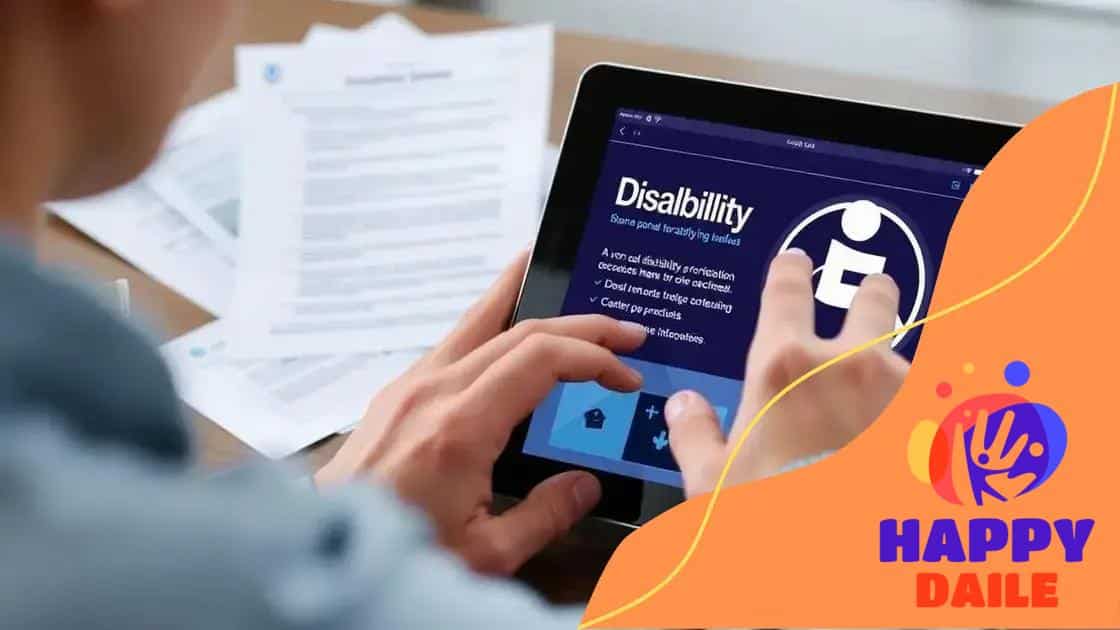How disability benefits are evolving in the U.S.

Anúncios
Disability benefits in the U.S. are evolving through improved technology, updated eligibility criteria, and increased support services, ensuring greater accessibility and advocacy for individuals with disabilities.
How disability benefits are evolving in the U.S. is a question many ask as changes surface. Knowing what’s new can help you navigate these benefits effectively. Have you considered how these updates might affect you or someone you care about?
Anúncios
Current state of disability benefits
The current state of disability benefits in the U.S. reflects ongoing changes and adaptations designed to support millions of individuals. Understanding these dynamics is essential for anyone navigating this complex landscape. Today, we explore the most significant aspects shaping disability benefits.
Key Features of Today’s Disability Benefits
Disability benefits vary based on specific criteria and requirements set by the Social Security Administration. Currently, eligibility hinges on several factors, including the severity of the disability and the individual’s work history. These features ensure that support is directed towards those most in need.
- The assessment of disability is based on how it impacts daily living.
- Duration of benefits can be affected by changes in health status.
- There is an ongoing review process to evaluate those receiving benefits.
Many people are unaware that disability benefits can also extend to dependents. This means that family members of individuals who qualify can receive assistance under certain conditions, expanding the safety net for families facing challenges.
Anúncios
How Benefits Are Distributed
Distribution of disability benefits has now shifted towards digital platforms. This change aims to simplify the application process. Using online tools can significantly reduce waiting times, making access to funds quicker and more efficient. However, some users may still face challenges with technology, which can create barriers.
More importantly, support services are now available to help individuals navigate the online system. These services are vital for ensuring everyone can access the benefits they deserve. Thus, understanding the available resources is key to maximizing support.
In summary, the current state of disability benefits is evolving to become more inclusive and accessible, though some areas still need improvement. Keeping informed about these changes can significantly enhance individuals’ ability to navigate the system effectively and ensure they receive necessary support.
Key changes in eligibility criteria
Understanding the key changes in eligibility criteria for disability benefits is crucial for those seeking assistance. Recent adjustments aim to make the process fairer and more accessible. Knowledge of these changes can greatly impact your or your loved ones’ ability to receive benefits.
New Eligibility Requirements
The eligibility criteria for receiving disability benefits have evolved. Changes include more detailed assessments of what constitutes a qualifying disability. This includes the severity of the condition and its impact on daily activities. Individuals are now evaluated not only based on medical evidence but also on their ability to perform work-related tasks.
- Conditions considered eligible have broadened to include various physical and mental health issues.
- Documentation requirements have been clarified to ensure consistency in applications.
- There is an increased emphasis on functional limitations stemming from disabilities.
Additionally, there have been changes in how income and assets are evaluated. This is intended to provide support for a wider range of individuals. Those previously deemed ineligible because of minor income issues may find new opportunities for assistance. Programs are continually updated to reflect current living costs and economic conditions.
Program Accessibility
With technological advancements, the process for applying for and maintaining disability benefits has improved. Online applications have been streamlined to ensure faster processing times. While these changes are beneficial, they also require recipients to be more informed about navigating digital platforms. Educational resources are available to help applicants understand their rights and options.
The impact of these key changes in eligibility criteria is significant. As policies adapt, it is essential for individuals to stay informed to fully utilize the resources available to them. Ensuring that all those who need support can access it creates a more inclusive system that benefits society as a whole.
Impact of technology on benefit distribution

The impact of technology on benefit distribution is profound, transforming how disability benefits are managed and delivered. With advancements in digital tools, the entire process has become more efficient and accessible for applicants.
Technology-Driven Applications
In the past, applying for disability benefits often involved lengthy paperwork and in-person visits. Today, applicants can use online platforms to submit forms and track their status. This shift reduces waiting times significantly and helps ensure a smoother experience.
- Online applications streamline the process, allowing for quicker submissions.
- Transparency in application status keeps recipients informed.
- Access to information and resources is easier through dedicated websites.
Additionally, the use of artificial intelligence aids in processing claims. Algorithms can quickly evaluate applications against set criteria, enabling faster decisions. This technological adoption not only expedites the approval process but also minimizes human error.
Challenges and Accessibility
Despite these advancements, it is important to recognize that not everyone has equal access to technology. Some individuals face barriers due to lack of internet connectivity or digital literacy. Addressing these challenges is crucial to ensure that all eligible individuals can benefit from available programs. Providing training and assistance in using online systems can help mitigate these issues.
The integration of technology into the distribution of benefits has also led to the creation of support apps. These can help individuals manage their benefits more effectively, providing reminders for deadlines and offering personalized information based on users’ unique situations. As technology continues to evolve, so too will its role in shaping disability support.
Overall, understanding the impact of technology on benefit distribution is essential for adapting to this changing landscape. Embracing these advancements can lead to a more efficient and inclusive system for everyone involved.
Understanding the appeals process
Understanding the appeals process for disability benefits is essential for those who may initially find their applications denied. This process allows individuals to challenge decisions made by the Social Security Administration and seek the benefits they believe they deserve.
Steps in the Appeals Process
The appeals process consists of several steps that ensure individuals have a fair chance to present their case. First, a claimant must request a reconsideration of the initial decision. During this stage, the case is reviewed again by a different examiner.
- Gather important documents to support your case, such as medical records.
- Submit your appeal within the designated time frame, typically 60 days.
- Keep detailed records of all communications and submissions related to your appeal.
If the reconsideration does not change the decision, the next step is to request a hearing before an administrative law judge. This provides an opportunity to discuss the case in detail and present additional evidence. Having legal representation can be beneficial at this stage, as they can effectively navigate the complexities of the law.
Importance of Documentation
Throughout the appeals process, documentation plays a crucial role. Medical evidence, financial records, and personal statements can all significantly impact the outcome. Ensuring that all evidence is well-organized and submitted on time can help strengthen your case. Furthermore, understanding the specific reasons for the initial denial can guide you in addressing those issues effectively.
Appealing a decision is often a lengthy process, but it is an important route for those who believe they qualify for benefits. Being knowledgeable about the appeals process and prepared to advocate for yourself can make a significant difference. Familiarizing yourself with the necessary steps and requirements can empower you to pursue the benefits you need.
Future trends in disability support
The future trends in disability support are focused on enhancing accessibility and efficiency for individuals seeking assistance. As society evolves, so do the methods of providing support to those with disabilities. Understanding these trends can help individuals and families better prepare for the changes ahead.
Technology Integration
One of the most significant trends is the integration of technology. Digital platforms now play a crucial role in how benefits are applied for and managed. This includes the use of mobile applications that allow users to track their claims easily. Such technology not only simplifies the application process but also improves communication between applicants and agencies.
- Increased use of artificial intelligence in processing claims.
- Access to online resources and tools for applicants.
- Improved data management for timely decision-making.
Furthermore, telehealth services are becoming widely available, allowing individuals to receive necessary consultations without needing to travel. This is particularly beneficial for those with mobility challenges or those living in remote areas.
Policies and Advocacy
There is also a growing emphasis on policy changes that promote inclusivity. Advocacy groups are actively working to ensure that legislation reflects the needs of people with disabilities. New policies may focus on expanding eligibility criteria, increasing funding for programs, and enhancing support services.
This movement aims to foster an environment where individuals with disabilities can thrive. Community-based programs are becoming more prevalent, providing support at the local level. Such initiatives aim to empower individuals through skills training, employment resources, and social integration.
The focus on future trends in disability support emphasizes creating a more inclusive society. With ongoing advancements in technology and shifts in policy, the landscape for individuals with disabilities is set to become more supportive and accessible. Keeping informed about these developments can help individuals adapt and advocate for their rights effectively.
\n
FAQ – Frequently Asked Questions about Disability Benefits
What are the main eligibility criteria for disability benefits?
Eligibility typically includes having a qualifying medical condition that significantly impacts daily living, based on established criteria.
How does technology improve the application process for benefits?
Technology facilitates online applications and trackable claims, speeding up processing times and improving communication.
What should I do if my disability benefit claim is denied?
You can appeal the decision by providing additional documentation and evidence that supports your case during the appeals process.
Are there support services available for navigating disability benefits?
Yes, many organizations offer resources and assistance to help individuals understand and apply for disability benefits effectively.





